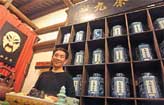Art
Skateboarding in a half-pipe house
Updated: 2011-07-31 08:27
By Steven Kurutz (The New York Times)
|
A prototype of a house in which every surface is skateable was tested at a gallery in Paris. A final version for 10 skateboarders will be built in California. Sam McGuire / Etnies |
Last year, Francois Perrin, an architect in Los Angeles, was approached with an intriguing proposition. Pierre-Andre Senizergues, a former professional skateboarder and the owner of a sportswear company, wanted a house in which every surface was skateable.
For Mr. Perrin, who grew up skateboarding in Paris in the 1970s, the idea of designing a kind of livable half-pipe was irresistible. "I did work on skate parks, but this house was the first time I could merge these two passions," he said.
Mr. Senizergues and Gil Le Bon Delapointe, a fellow skateboarder and designer employed by Mr. Senizergues's company, worked on the initial concept and took the idea to Mr. Perrin. Everything in the final design can be skated on, even the kitchen counter (metal trim allows for grinding, which means sliding on an edged surface on axels). The dwelling looks like a long low-ceilinged oval from the side, with the living room at one end, a central chamber that contains a bedroom and bathroom and, at the other end, a dedicated skateboarding area.
In June, at "Public Domaine," an exhibition on skate culture at La Gaite Lyrique in Paris, which runs through August 7, a full-scale prototype of the house's living area was revealed to skateboarders. The final version of the house, with room for 10 skateboarders, will be built in Malibu, California.
Mr. Perrin recently spoke with a reporter.
Q. The walls of the house are curved like a skate ramp. Did skate ramps inform the design?
A. Usually skate ramps are just a half-pipe. If you keep the radius of a classic ramp, that would be too big of a structure as a house. The radius we used was tighter than a classic pipe. People aren't used to skating with anything above them. It almost creates a new kind of skating.
Q. What was your biggest challenge?
A. We're not putting furniture into a skate ramp, and we're not bringing skate elements into a house. From the beginning, it's something designed as this hybrid structure. The challenge was finding that balance between both: being technically skateable but also being livable.
Q. How do you keep the walls from getting scuffed up?
A. Usually on a skate ramp, you don't put a varnish on. In this case, we did because it's a house. So we found a varnish to protect the wood but not be too slippery. The walls are something that you can sand and revarnish. But it's also part of the design to have the trace of the skater and the movement.
Q. Can the house have conventional things like wall art and exposed light switches?
A. If you're talking about a flat painting, you could still place it in the house. The light switches could be recessed. You have to create something that's functional for a house and skating.
Q. Do you think skateboarders have an inherent appreciation of space and architecture?A. Skating has a strong relation with architecture. They adapt themselves to public space and outdoor furniture. A skater, when he goes around the city trying to find the right space and surface, he looks at architecture with a different eye. So this idea of people skating in a house has been the dream of many generations of skaters.
The New York Times
E-paper

Double vision
Prosperous Hangzhou banks on creative energies to bridge traditional and modern sectors
Minding matters
A touch of glass
No longer going by the book
Specials

Carrier set for maiden voyage
China is refitting an obsolete aircraft carrier bought from Ukraine for research and training purposes.

Pulling heart strings
The 5,000-year-old guqin holds a special place for both european and Chinese music lovers

Fit to a tea
Sixth-generation member of tea family brews up new ideas to modernize a time-honored business

